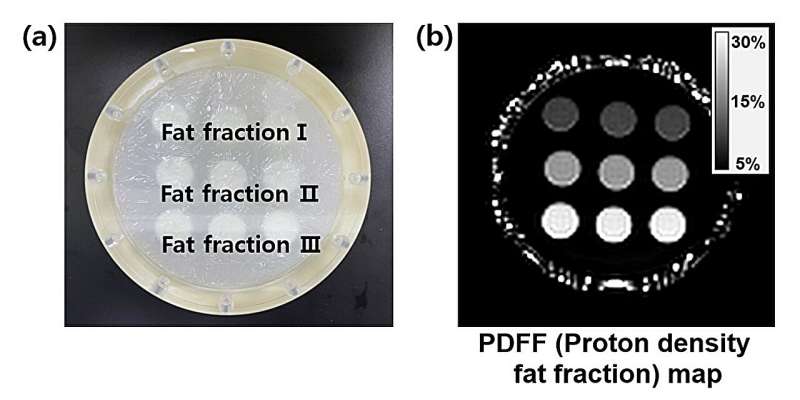The Korea Research Institute of Standards and Science (KRISS) has developed the world’s first reference material to improve the accuracy of body fat measurements conducted through MRI and CT scans. The study is published in the journal Metrologia.
This newly developed reference material for medical imaging systems is an emulsified substance created by mixing water and fat. When inserted into a phantom and applied to medical imaging systems, it can serve as a reference for fat measurement. The principle is to analyze the water content within the reference material to calculate the fat amount.
Medical imaging systems like MRI and CT are widely utilized for diagnosing chronic conditions such as fatty liver disease as they can non-invasively assess body fat levels, unlike invasive biopsies.
The issue has been the variability in fat measurement values from medical imaging systems, differing by hospital, manufacturer, and model. Since there are no calibration standards, diagnosis relies on the experience and intuition of physicians, posing challenges for multi-center clinical trials and big data research that require consistent measurements from various imaging systems.
Phantoms that mimic body fat have been introduced and are being used. However, they are unstable because they contain around ten additives, including artificial surfactants, and there is a lack of objective verification procedures for the amount of substances.

The reference material developed by KRISS is free of additives that affect measurement values, ensuring precise fat content measurement. It also offers high stability and homogeneity. This development is the result of collaborative research across three departments within KRISS, integrating chemical water measurement technology and ultrasonic emulsification techniques in the field of medical imaging.
The newly developed reference material and phantom are expected to be distributed to medical institutions, improving the validity of medical imaging system measurements and the reliability of diagnostic results. In addition, they can serve as reference points for multi-center and multi-device data in clinical trials for new drug development, including obesity treatments. Currently, Siemens Healthineers, the leading company in the domestic MRI market, is utilizing this new technology in research on measuring fat content with MRI equipment.
Hyo-Min Cho, principal research scientist of the KRISS Medical Metrology Group, said, “The significance of our interdisciplinary study lies in addressing clinical needs in the medical field. We will continue to contribute to public health by developing technologies that bridge the medical and scientific communities.”

Professor Dong Wook Kim from the Department of Radiology at Asan Medical Center, who supported the validation of the reference material, stated, “We will use this reference material in future clinical trials and patient-specific disease diagnosis to obtain more accurate and consistent data.”
KRISS plans to conduct follow-up research to distribute additional reference materials with refined concentrations, and contribute to establishing a next-generation performance evaluation system for medical imaging devices based on multi-center data.
More information:
Sunyoung Lee et al, Development and evaluation of emulsified reference materials for magnetic resonance imaging, Metrologia (2024). DOI: 10.1088/1681-7575/ad1f7f
Citation:
A new reference material sets standard for MRI and CT diagnosis of fatty liver (2024, June 28)
retrieved 28 June 2024
from https://medicalxpress.com/news/2024-06-material-standard-mri-ct-diagnosis.html
This document is subject to copyright. Apart from any fair dealing for the purpose of private study or research, no
part may be reproduced without the written permission. The content is provided for information purposes only.

